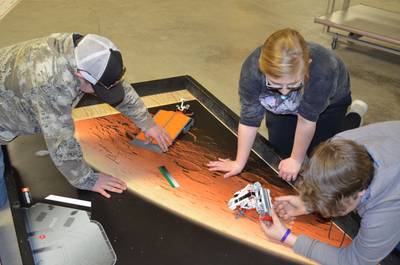Robotics Project
Project Description
Robotics introduces science, math, engineering, art and technology skills while teaching life skills. There are two different kinds of projects available in Robotics. The EV3 project (Spike Prime coming soon!) is designed to be used with the Lego robotics kit, and the Junk Drawer project is designed to be used with everyday household materials. Some robotics curriculum is updated by online vendors during the year–please check online at the 4-H website for the latest available versions.
Project Requirements
Project Books Required? Yes
Project books can be purchased here
*** Please note, if you do not attend at least one workshop in your project area during the 4-H year, you will be required to complete activities in your project book and turn it in with your record book. The number of activities required to complete a 4-H year in each project book can be found here.
Project age limit? 8 and up
First Year Junk Drawer Robotics:
- Junk Drawer Robotics 1 (7 activities and record book check)
- Cost at this time is only for the workbooks and notebook
- Science, technology, arts, engineering and math (STEAM) basics, Robotics basics
- Use of the experiential model and learning process/building life skills
- The first project is a marshmallow catapult
- All levels of Junk Drawer can enter the fair with their projects
What needs to be accomplished to move on to level 2 of Junk Drawer Robotics?
- Junk Drawer Robotics 1 (7 activities and record book check), takes 2 years to complete
- Robotics basics
- Use of the experiential model and learning process/building life skills
- The final project involves using everything learned to build a robot arm
What needs to be accomplished to move on to level 3 Junk Drawer Robotics?
- Junk Drawer Robotics 2 (7 activities and record book check), takes 2 years to complete
- Applied math and science to continue robotics knowledge
- Use of the experiential model and learning process/building life skills
- The final project involves making a moving/mobile robot on wheels- introduction of mechanical and electrical automation
What needs to be accomplished to move to the next levels from here Junk Drawer Robotics?
- Junk Drawer Robotics 3 (7 activities and record book check), takes 2 years to complete
- Continue to develop and use the experiential model/learning process to combine all parts of robotics building
- Electronic circuits, simple sensors, base 2 system, programming, and robotic builds
- Requires a lot of new technology, as these builds use more and more complex items
First-year EV3
- Plan on time during the project to develop skills based on EV3 workbook and meetings.
- Cost at this time is only for workbooks, which can be found by clicking the link above.
- Use of the experiential model and learning process/building life skills
- We will also discuss fair and possible field trips/competitions later in the year (which will occur during the spring/summer and at Fair time).
After the first year EV3
- Will be doing more advanced projects and challenges based on personal progression during the project year.
What should new members know?
- First year Junk Drawer Robotics (J.D. Robotics 1), plan on progressing through the first module(s), and making marshmallow catapult. Simple mechanics will be discussed, and we'll be using hands on learning. Be sure to purchase the J.D. Robotics 1 project book and notebook.
- J.D. Robotics after the first year will continue to advance as the 4-H member advances. Will be working on building a robotic arm with items found around the house and purchased for project meetings.
- For J.D. Robotics 2 & 3, project books will need to be purchased. Fair and other possible trips will be discussed as they come up.
- Additional costs may be discussed at meetings as the program is developed.
- This is my third year of robotics, and I am building a program to best facilitate learning and personal growth. This past summer we received a grant and are in the process of purchasing the new Lego Spike Prime kits. As I learn about new events and opportunities, I will share them as they present themselves.
Workshops for the 2024-2025 4-H Year
From 5:30PM-7:30PM
- November 21st at First Baptist Church Montana (201 8th Ave. N.)
- December 19th at First Baptist Church Montana
- January 16th at First Baptist Church Montana
- February 20th at First Baptist Church Montana
- March 20th at First Baptist Church Montana
- April 17th at First Baptist Church Montana
- May 15th at First Baptist Church Montana
- June TBD
- July Fair
Project Superintendent Information
Robotics Superintendent: Russell Reed
Contact: russell.reed1.rr@gmail.com or 406-579-9119
How will you be contacted? Email
The U.S. Department of Agriculture (USDA), Montana State University and the Montana State University Extension Service prohibit discrimination in all of their programs and activities on the basis of race, color, national origin, gender, religion, age, disability, political beliefs, sexual orientation, and marital and family status. Issued in furtherance of cooperative extension work in agriculture and home economics, acts of May 8 and June 30, 1914, in cooperation with the U.S. Department of Agriculture, Jeff Bader, Director of Extension, Extension Service, Montana State University, Bozeman, MT 59717